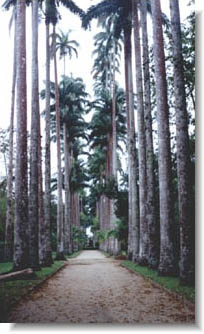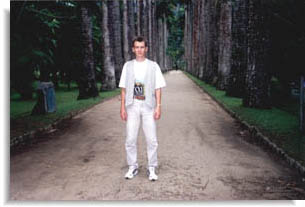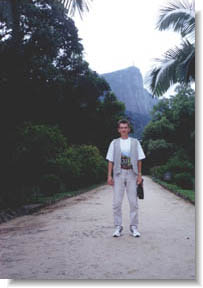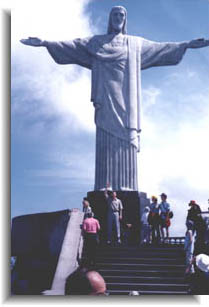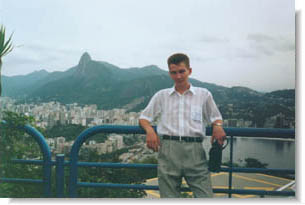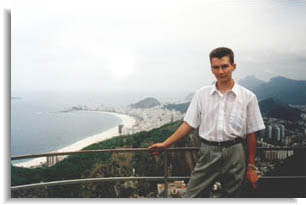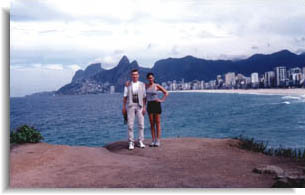 Twenty two hours by bus, and I
am in Rio de Janeiro. Rio is a very beautiful city.
Twenty two hours by bus, and I
am in Rio de Janeiro. Rio is a very beautiful city.
I stayed at a hotel in Rua Visconde de Piraja two block from the Rio's richest and most chic beach called Ipanema. Ever been to Rio? Then you might recognize the Atlantic ocean, Ipanema beach and the hills on the background at the picture to the right.
Some pictures and words about most impressing sights in Rio.
Jardim Botãnico was created in 1808 by D. João VI to acclimatize the seedlings of species brought from Europe. It has 8200 species of plants and flowers from all over Brazil and other parts of the world.
The most famous are the imperial palm trees - brought from Maurice Islands. They were planted in the year of the inauguration of the garden and they are along the path from the main entrance to the central fountain. Other attractions are the stoves of orchids and bromelias.
At the left, you see me in the Botanical Garden, while in the distance one can recognize Morro do Corcovado hill.
Morro do Corcovado, a 710 m above the sea level, the hill offers one of the most beautiful views of the city, besides holding the statue of Jesus Christ (Cristo Redentor). Inaugurated on October 12th, 1931, it weights 1145 tons and measures 38 m in height (including the 8 m of the pedestal, where there is a chapel). To arrive to the main terrace one must climb 222 steps. The ascent with a little train is made by Railroad of Corcovado, which was inaugurated by D. Pedro II in 1884 and is one of the oldest railroads of the country.
Rio is divided into a zona norte
(northern zone) and a zona sul (southern zone) by the Serra da Carioca,
steep mountains that are part of the Parque Nacional da Tijuca. The view
from the top of Corcovado, the mountain peak with the statue of Christ the
Redeemer at its summit, offers the best way to become geographically
familiar with the city. Favelas crowd against the hillsides on both sides
of town.
Pão de Açúcar (Sugar Loaf) is God's gift to the picture-postcard industry. Two cable cars climb 1300m above Rio and the Baía de Guanabara and, from the top, Rio looks the most beautiful city in the world. The 120 sq km Parque Nacional de Tijuca, 15 minutes from the concrete jungle of Copacobana, is all that's left of the tropical jungle that once surrounded Rio.
The beach, a ritual and a way of life for the Cariocas, is Rio's common denominator. Copacabana is probably the world's most famous beach, and runs for 4.5km in front of one of the most densely populated residential areas on the planet. (It is also the place where you are most likely to be robbed in Brazil as it happened to me too.) From the scalloped beach you can see the granite slabs that surround the entrance to the bay.
Four days passes and time to return home came. I took a bus to São Paulo - the biggest city in South America, and in a day flew out back to Moscow. >>
